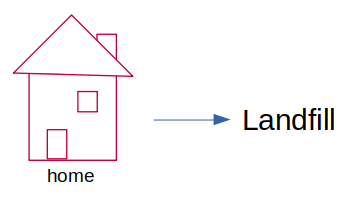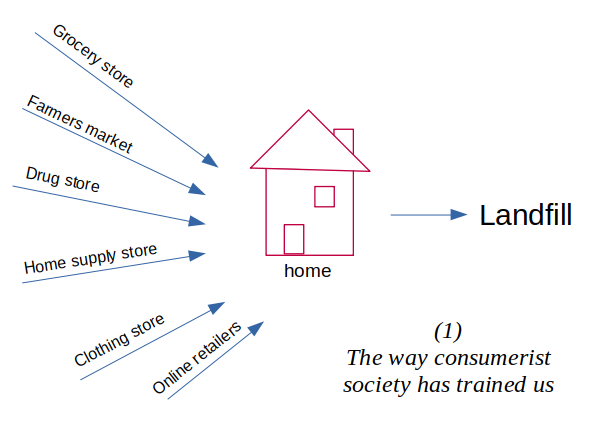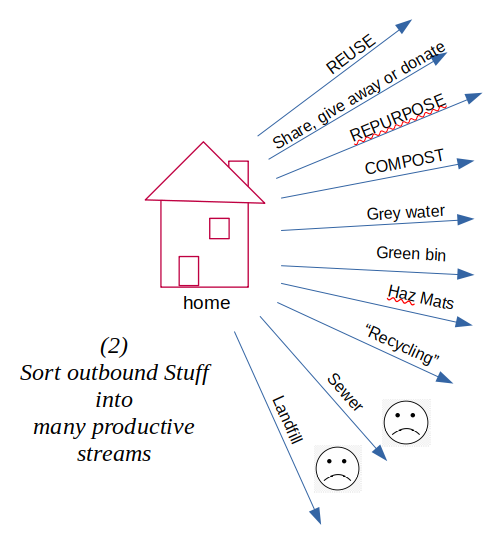
Rethink waste
When I was growing up, my mother politely referred to the cylindrical cans as “waste baskets.” Perhaps we should return to that term. Because everything we put into them, headed to the landfill, is indeed a waste of earth’s resources.
When my kids were small, I labeled our cans. They read “compost”, “recycling”, and “landfill”. The last one carried a sad-face emoji. It worked really well at birthday parties, when we had lots of people over to the house — it made people think before they tossed.
What if all our cans were labeled like this?
Conventional consumerist society has trained us — too well — to focus only on the inflow, always increasing that inflow, giving little thought to the outflow. (diagram 1)

Now, with ecological equilibrium so very far out of balance, we need to rethink everything. The outflow streams from our homes and businesses are no exception.
The jingle many of us learned in grade school said “Reduce, Reuse, Recycle.” This little jingle is in priority order. The highest good is to Reduce the inflow, Reduce the overall amount we consume. Reduce how much comes inbound via each of those arrows in diagram 1.
The second-highest good is to Reuse. This is where contemporary society falls flat. In the pursuit of more-more-more income and profits, The Economy has trained us all to Buy New Stuff rather than repairing broken stuff and continuing to use it, or repurposing old stuff for another function, or turning old Stuff into craft materials for our abundant creativity.
Contemporary society has put a disproportional, inappropriate emphasis on so-called “Recycling,” and trained us to give ourselves a pat on the back when we participate in the broken “recycling” system, as if that’s somehow greener. But we can do much better than that.
A waste audit
Observe your habit patterns around your home. Where and how does Stuff leave your property? Consider “trash day” — where does all that Stuff go?
What is the make up of the Stuff that leaves your property? What further use could each item be put to? Can you direct each item to a higher use?
Revising your outflow
The outflow from your home should have many outlets — perhaps even more than the inflow.
The outflow from your home should focus on Reuse: how can this item be used again, and again, and again, before it ultimately is no longer useable.
When you shift to this kind of thinking, you’ll realize that certain items are very difficult to Reuse. For example, most plastics are pretty much stuck in the use-it-once-and-throw-it-away-to-landfill category. At some point you’ll shift to boycott: no longer welcoming that use-it-once stuff into your home at all.
But, back to our discussion of outflows: Let’s take a look at possible outflows (diagram 2) one at a time.

Outflow options
Reuse: This refers to reusing an item, at its current geography, in its current form, for its original purpose, again and again for as long as possible. It’s here at your home, the investment of earth resources + fossil fuels + greenhouse gas emissions to get it to your home has already been made. It’s on you to value that investment and truly use the thing. Example: a ceramic coffee mug.
Expand its use from just coffee, to serving your soup, sipping your wine, measuring your rice, watering your house plants, use it again and again until it has a sad accident and falls apart.
Reuse demands a values shift, away from thinking that new is somehow better, away from the fashionable style of the moment, toward valuing rich patina, and surrounding ourselves with well-used and well-loved objects for use in our lives.
Giveaway/donate: This refers to relocating an item to a different geography, other than your home, where it can be reused, in its current form, for its original purpose, again and again for as long as possible. Example: outgrown gently-used baby clothes given to a friend who has a younger child.
Giveaway/donate requires some thought as to who can truly use the Stuff. If this is done thoughtlessly, it is merely shoveling your outbound problem onto the shoulders of someone else, and that’s not cool. Example: donating terribly worn, unusable stuff to Goodwill, to that Goodwill now has a waste-disposal problem.
Repurpose: This refers to reusing an item in your same geography, for a different purpose than its original use, possibly in different than its original form. Example: worn clothing used as cleaning rags; a plastic food container rinsed out and used to store garden seeds; old baby clothes cut up to make a keepsake quilt, the shards of that broken coffee mug used to make beautiful mosaics.
Note that I included “in your same geography.” If you’re thinking you’ll hand it off to someone else to be repurposed, that’s shoveling, not cool. However if someone asks you for it (“Can you donate ceramic shards for this great art project I’m building?”), that’s a proper repurposing.
Repurpose is where we can get really creative. Reuse and Repurpose are where we can save money, by choosing not to buy new Stuff, by using the Stuff we already have, for which our culture has already made the earth resources + fossil fuels + greenhouse gas emissions investment.
It’s on us to boost our level of Reuse and Repurpose to much higher levels than we’ve ever done before.
Compost: Composting is Mother Nature’s Reuse system for all things-that-used-to-be-plants.
Participating in composting systems may take several forms.
- traditional backyard compost pile.
- worm composting (which can be done indoors, and can be done even if you’re in a rental, an apartment, or a condo)
- community compost hubs, where you can take your compostables, where someone else will put them in a community-scale pile. In my area, these are beginning to show up at farmers’ markets. Search for a community compost site in your local area.
Composting represents a values shift, away from thinking of those carrot tops as garbage, and toward recognizing that those carrot tops are part of massive direction change and large-scale solutions. Right now we need to be building living soil. We need to be returning things-that-used-to-be-plants to the earth, where Ma Nature can use them in building healthy ecosystems, and sequestering carbon to stabilize global warming. No more landfill or dispose-all for those carrot tops and plate-scrapings!
This is highly valuable material, and we need to start treating it as such.
Greywater: Greywater systems are Reuse systems for water. refer to my other posts for discussion of sewers and greywater.
Green bin: In many cities, in neighborhoods with a lot of houses, there is typically a green-bin program. In the eyes of waste management, this is “diversion” — keeping things-that-used-to-be-plants out of the landfills (where they not only took up much-needed space, but also contributed to methane gas production, methane being a powerful greenhouse gas).
Most cities haul green bin contents to a municipal yard, run them through a chipper machine, and either use the results on city property, or offer Free Mulch to citizens. Some cities invite you to put your household compostables, like kitchen scraps, into your green bin.
The higher good would be to use your things-that-used-to-be-plants in the geography where you live. Hoiwever, if you cannot use them on the immediate property around your home, putting them into a green bin is your next best option. For apartment/condo/rental dwellers, see above comments about community compost hubs.
Haz Mats: In all of this discussion, it’s important to acknowledge that our tech society has designed and built things that are very hazardous and toxic, things which should never be tossed into compost, green bins, or landfills, things which require special handling in order to keep us all safe. Examples: all batteries, all electronics, paint, etc. (LA Dept of Sanitation Haz Mat list is here)
In my home, we have some old glass containers (repurposed fishbowls! glass because it’s best for containing any leaks) where we collect them, then we periodically take them to an official Haz Mat site for proper disposition. Even renters should have their equivalent to the “fishbowl.”
Recycling: refer to my other posts to understand what true Recycling is, as contrasted with the mythology within our society’s current recycling programs. The other solutions in this post, including reducing inflow and boycotting, represent much higher uses than the so-called “recycling” system.
Sewer: The sewer — which means all your toilets and drains — is not a substitute for proper disposition. The toilet is not a trash can. You should never put medications down the drain or into the toilet, they should go to your local Haz Mat site.
Food waste should go into the Compost. Better yet, give serious focus to Reduce! The “dispose-all” machine beneath your kitchen sink should only be used for clearing the build-up of small-particle gunk.
refer to my other posts for discussion of sewers and greywater.
Landfill: Landfill and sewer are labeled with a sad face, because sending Stuff to these locations means you’re tossing it into a pile of crazy-mixed-up (therefore toxic) stuff, stuff which will never be reused, stuff for which the societal investment of earth resources + fossil fuels + greenhouse gas emissions has truly been wasted. Everything we, as a society, channel to landfill and sewer is a failure on our part.
Thus “diversion” away from landfills becomes the ultimate goal.
How low can you go, in reducing how much you throw into the Landfill bin? How empty can you make your “trash” can?
Space
“But my home’s tiny, I don’t have space for all that sorting!”
The band-aid “solution” is to move Stuff out to its eventual outflow even more rapidly, don’t let it build up.
The real solution is to assert control over your inflow.
At work
Are you a business owner or manager? Apply this diagram to your place of business.
Invite all your supply vendors to think about it as well. Beware of outsourcing, where waste happens out-of-sight, out-of-mind.
Label the cylindrical cans at your business: Compost. Recycling. Landfill (sad face) …
Perhaps your business could add additional cans to feed cycles of Reuse. Example: Chipotle restaurants once had a shelf above their Landfill can for you to stack their reusable trays. What systems of Reuse can your business implement?
Work the interconnection between outflow and Inflow
When you “need” a new thing, train yourself to first look around your place, see what you already have (investment ofearth resources + fossil fuels + greenhouse gas emissions has already been made). What might you Reuse or Repurpose to fill this need, rather than buying new?
Habit change, to take that pause and ask yourself that question, helps you “level up” in your stuff management, in your waste reduction, in your financial savings and ecological savings because you’re learning to control your buying-new pattern.
The challenge
It’s on each of our shoulders, and it’s our responsibility to teach our kids: Reduce the inflows, and shift all the outflows toward systems of Reuse and Repurposing.
